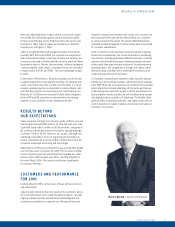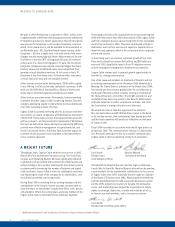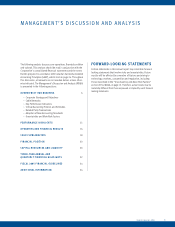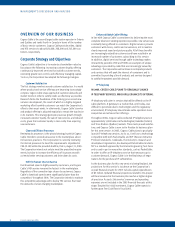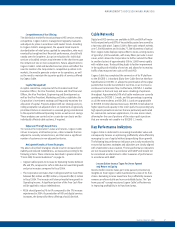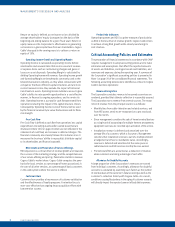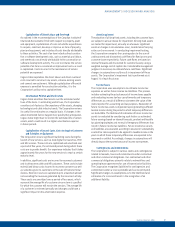Cogeco 2004 Annual Report Download - page 15
Download and view the complete annual report
Please find page 15 of the 2004 Cogeco annual report below. You can navigate through the pages in the report by either clicking on the pages listed below, or by using the keyword search tool below to find specific information within the annual report.
MANAGEMENT’S DISCUSSION AND ANALYSIS
Cogeco Cable Inc. 2004 13
Distribution systems will evolve towards integrated IP platforms
with more efficient data transfer techniques and protocols, together
with more information and entertainment content, including IP
based video programming services, altogether made available
to end users via HSI connections. As this evolution takes place,
the traditional role of broadband operators as preferred retailers
of video programming services and their core business of video
distribution could change because of competition from video
content suppliers distributing directly to customers via IP
transmission platforms.
Technological Change
Broadband distribution technology is evolving at an increasingly
rapid pace, yielding more efficient and economical solutions for
the various types of existing wireline and wireless distribution
systems, and generating new marketable solutions for broadband
services such as video, audio and data transmission through
electrical distribution lines. Also, local wireless broadband connec-
tions may become a substitute for already deployed broadband
wireline connections, including cable drops. Technological change
and the ensuing competitive pressures may require significant
additional capital investment in property, plant and equipment
in future years. There is no assurance that funds generated by
the business will support these further capital investments, if
and when they are required, or that the business will generate
the anticipated return on the capital that must be invested.
IN FISCAL 2004, COGECO CABLE STARTED TO OFFER AN ALL-
DIGITAL CHANNEL LINE-UP IN SOME OF ITS CABLE SYSTEMS.
EVENTUALLY, ALL CUSTOMERS WILL BENEFIT FROM DIGITAL
DISTRIBUTION OF ALL PROGRAMMING SERVICES
.
Like most cable operators in North America, Cogeco Cable will
eventually complete a transition from analog to digital distribution
for all programming services. This transition involves technical
challenges that vary depending on the state and characteristics
of each local cable system. Duplicate distribution of a number of
programming services may be required for several years before
the transition to fully digital distribution is completed, at the
expense of more flexible and efficient cable bandwidth usage.
The transition is also complicated by the advent of more evolved
digital television formats such as HD. Since Cogeco Cable’s
satellite and microwave competitors commenced their operations
as fully digital distributors from the outset, they do not face
the same transition from analog to fully digital distribution;
they do face however the same need to accommodate the more
bandwidth-intensive HD format.
Regulation
The activities of Cogeco Cable are regulated mainly under the
authority of the Broadcasting Act (Canada) and the Telecommu-
nications Act (Canada). While Cogeco Cable competes on a range
of broadcasting distribution and telecommunication services
with other broadband distributors and incumbent telephone
companies, some of which are comparatively much larger and
more integrated, it must still comply with a number of detailed
regulatory requirements affecting many aspects of its business,
including cable plant design and use, sharing of distribution
plant and inside wiring in buildings, terms for the distribution
of Canadian programming services, retail service packaging
and commercial solicitation of customers.
Several regulatory proceedings now pending before the CRTC,
including proceedings on the regulatory framework for VoIP
telephony, the bundling of broadcasting and telecommunication
services, the use of advertising availabilities on non-Canadian
programming services, and the distribution of HD signals of
pay and specialty television programming services, have the
potential to significantly affect the competitive position of
Cogeco Cable, its operations and its financial condition
depending on the final outcomes.
The Corporation is also subject to Canadian ownership and control
requirements that limit the extent to which equity can be issued
to non-Canadian residents and that preclude control by non-
residents. While Canadian ownership and control requirements
for broadcasting and telecommunications carriers have been
questioned during the past few years, Cogeco Cable and other
Canadian cable operators may well remain subject to these
requirements for the foreseeable future.
Cost of Sales and Operating Costs
Several factors have the potential to adversely affect Cogeco
Cable’s cost of sales and operating cost structure. Cost of sales
is mainly comprised of fees for programming services and movies,
fees for copyright collectives and fees for suppliers of long haul
data transmission facilities for HSI access services. Fees for pro-
gramming services and fees for movies offered on the VOD service
are, for the most part, negotiated with a small number of large
integrated broadcasting groups and major studios. Several program
licensing agreements are currently under negotiation. In the case
of Canadian programming services however, the CRTC may even-
tually set distribution terms, including wholesale fees payable
to the programming service supplier.


